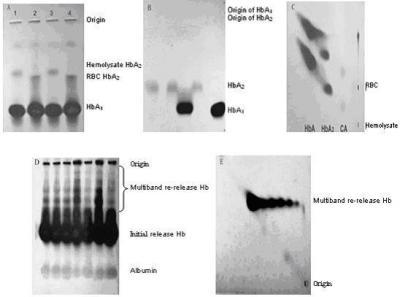Professor Qin Wenbin from BaoTou Medical College first identified the hemoglobin (Hb) A2 phenomenon 30 years ago. His first paper on this phenomenon was published in Acta Biochimica et Biophysica Sinica, in Chinese, in 1981. Subsequent research investigating its mechanism was published in Chinese in the Chinese Biochemical Journal and Progress in Biochemistry and Biophysics in 1991 and more recently in Electrophoresis, in 2010. Using electrophoretic methods, he discovered that Hb is re-released in living red blood cells (RBCs) and demonstrated the significance of this process in theory and in clinical practice. His paper was published in Electrophoresis in 2009. He has since reported a compendium of his findings in a paper entitled "Electrophoresis release of hemoglobin form living red blood cells in Chinese in Scientia Sinica: Life Sciences (2011, issue No. 8) His work has opened up a new field of Hb research.
Most proteomics studies are conducted in a typical manner in which cells are lysed to release protein, after which the intended analyses are conducted. This is particularly true for red blood cells. Lysis of red blood cells releases Hb and the resulting mixture is called the hemolysate. It has long been considered that the analysis of proteins in hemolysate can reveal the true conditions inside the RBCs. However, it was unknown whether Hb obtained from the lysed RBCs had similar properties to Hb in intact living RBCs.
Therefore, in 1981, Professor Qin began comparing intact living RBCs with their hemolysate and found that the electrophoretic position of all Hbs, except for HbA2, were the same in both samples. However, the cause and the mechanism of this phenomenon—termed the HbA2 phenomenon—were unknown.
In 1991, to demonstrate the mechanism of the phenomenon he designed two new methods to test the interactions between Hbs, namely (1) Hb cross electrophoresis in starch-agarose mixed gel and (2) Hb bidirectional diagonal electrophoresis in starch-agarose mixed gel. Hb cross electrophoresis demonstrated that, HbA2 could interact with HbA1 outside RBCs. Meanwhile, bidirectional electrophoresis revealed that HbA2 could also interact with HbA1 inside RBCs. In the first direction of electrophoresis, HbA2 and HbA1 were bound together but, in the second direction of electrophoresis, both molecules were moved away from the diagonal. This finding suggested that the HbA2 phenomenon is caused by an interaction between HbA2 and HbA1 within the RBC. In other words, Hbs do not exist solitarily but are actually dependent on each other and joint carry out their physiological functions. Unlike the electrophoretic release of Hb from living RBCs, the HbA2 phenomenon was not found in the hemolysate of lysed RBCs. Therefore, it was not surprising that the interaction between Hbs within the RBCs could not be detected. Based on these findings, in 2010, he further investigated the mechanisms involved in the HbA2 phenomenon using SDS-PAGE and mass spectrometry methods. Using these methods, he found that HbA2 did interact with HbA1. He also found that Prx-2 may be involved in the HbA2 phenomenon. "Thirty years have drifted by since I began the work…" Qin sighed with emotion, "…and I'm 83 now. The discovery of interaction between hemoglobins in the RBCs can be taken as my tiny gift I presented to human beings. It should be regarded as a beginning of investigations on the interactions between proteins within the cell with the method of electrophoretic release."

A: The HbA2 phenomenon. B: Cross electrophoresis. C: Bidirectional diagonal electrophoresis. D: Unidirectional multiband re-release of Hb. E: Bidirectional multiband re-release of Hb.
(Photo Credit: ©Science China Press)
One day in 2007, the power supply for the electrophoresis was accidentally cut off while he was exploring the mechanism of HbA2 phenomenon. However, the experiment was not abandoned. The electrophoresis continued when the power was on and a wonder appeared! In addition to the HbA2 phenomenon, other Hbs were released from the original cells. In order to verify this finding, he repeated the experiment many times using pause–run (off–on) controls, which yielded similar results to those of the first experiment. Because the Hbs were released again and again in the above-mentioned experiments, this process was termed electrophoretic re-release of Hbs from RBCs. Accordingly, the HbA2 phenomenon represents the initial electrophoretic release of Hbs within RBCs. It is interesting to note that electrophoretic re-release can be repeated many times in the same experiment, and many bands of Hbs can be released by pause–run control. This phenomenon is referred to as multiband re-release.
At the same time, he met a family with mild thalassemia and did experiments using blood samples from this family and from healthy individuals. The results of these studies showed that multiband re-release of Hbs occurred significantly more frequently in blood samples from individuals with thalassemia compared with those from healthy individuals. As a result, he began searching for a possible relationship between re-release and this disease.
He has since made many important discoveries including a positive correlation between blood sugar levels with the increase in multiband re-release of Hbs from RBCs of diabetic individuals, as well as enhanced multiband re-release in patients with intrahepatic biliary duct cancer, which is more pronounced than that in patients with thalassemia.
Professor Qin has opened up a new area of research, and some of his achievements have been introduced into clinical practice.
Source: Science in China Press